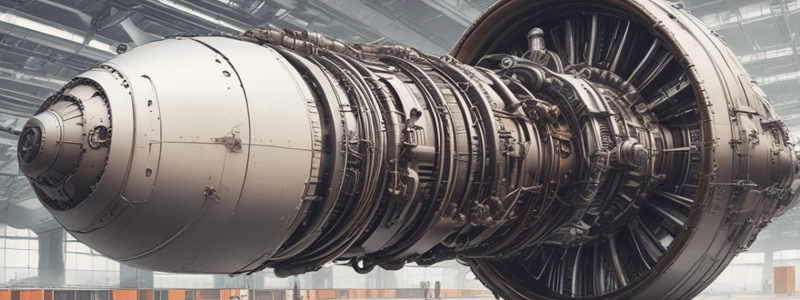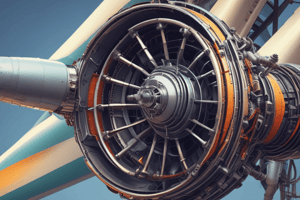Podcast
Questions and Answers
Where does ram air to the engine enter through?
Where does ram air to the engine enter through?
- The carburetor inlet
- The intake manifold
- An opening in the forward part of the lower engine cowling nose cap (correct)
- The cylinder head
What is the purpose of the valve in the induction airbox?
What is the purpose of the valve in the induction airbox?
- To permit air from an exhaust heated source to be selected (correct)
- To regulate the amount of fuel mixed with air
- To filter the air entering the carburetor
- To distribute the fuel-air mixture to each cylinder
How are the intake pipes attached to the intake manifold?
How are the intake pipes attached to the intake manifold?
- With a socket and pin
- With a single bolt and nut
- With a two bolt flange and gasket
- With hose and clamps (correct)
What happens to the air after it is filtered through the filter?
What happens to the air after it is filtered through the filter?
What is the purpose of the carburetor?
What is the purpose of the carburetor?
What is the primary purpose of the filter located at the opening in the nose cap?
What is the primary purpose of the filter located at the opening in the nose cap?
What is the function of the two-bolt flange on the intake pipes?
What is the function of the two-bolt flange on the intake pipes?
What is the effect of operating the carburetor heat control in the cabin?
What is the effect of operating the carburetor heat control in the cabin?
What is the purpose of the hose and clamps on the intake manifold?
What is the purpose of the hose and clamps on the intake manifold?
What is the function of the intake manifold?
What is the function of the intake manifold?
Flashcards are hidden until you start studying
Study Notes
Air Induction System
- Ram air enters the engine through an opening in the forward part of the lower engine cowling nose cap.
- The air is filtered through a filter located at the opening in the nose cap.
- The filtered air is directed to the inlet of the carburetor, mounted on the lower side of the engine.
- In the carburetor, fuel is mixed with the air to create a fuel-air mixture.
- The fuel-air mixture is distributed to each cylinder by separate intake pipes attached to the intake manifold.
- The intake pipes are attached to the intake manifold with hose and clamps, and to the cylinder with a two-bolt flange sealed with a gasket.
Anti-Icing System
- The induction airbox contains a valve operated by the carburetor heat control in the cabin.
- The valve permits air from an exhaust-heated source to be selected in case of carburetor icing or filter icing.
Air Induction System
- Ram air enters the engine through an opening in the forward part of the lower engine cowling nose cap.
- The air is filtered through a filter located at the opening in the nose cap.
- The filtered air is directed to the inlet of the carburetor, mounted on the lower side of the engine.
- In the carburetor, fuel is mixed with the air to create a fuel-air mixture.
- The fuel-air mixture is distributed to each cylinder by separate intake pipes attached to the intake manifold.
- The intake pipes are attached to the intake manifold with hose and clamps, and to the cylinder with a two-bolt flange sealed with a gasket.
Anti-Icing System
- The induction airbox contains a valve operated by the carburetor heat control in the cabin.
- The valve permits air from an exhaust-heated source to be selected in case of carburetor icing or filter icing.
Studying That Suits You
Use AI to generate personalized quizzes and flashcards to suit your learning preferences.




